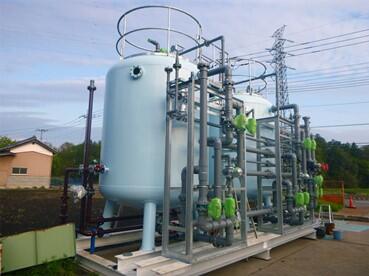NEC Facilities (Minato-ku, Tokyo) has developed the first technology in Japan that can achieve stable and efficient removal of the boron present in the leachate generated from an industrial large-scale landfill site. This is a special adsorbent based on cellulose fibers, with the addition of technology to minimize the adsorption effect of the inhibitors contained in the leachate, where it was applied to a landfill site for industrial waste and a one-year demonstration of operation was conducted. The results confirmed stable operation and significant reduction in running costs, which were one-sixth that of conventional products. The company is pursuing application of this technology, aiming for sales of 2 billion Japanese Yen over the next five years.

Provided by NEC
The leachate generated at the waste landfill site contains a wide variety of components derived from the substances that make up the waste. Boron, which is a difficult substance to remove, is one of the components of the leachate, and normally, a granular chelate adsorbent based on a resin is used to remove boron. In response, NEC Facilities collaborated with Chelest Corporation to develop a fibrous chelate adsorbent based on fine cellulose fibers, with excellent boron adsorption rates and amounts, that can be applied in large-scale equipment to significantly reduce running costs, and remove boron in wastewater. Although this fibrous chelate adsorbent has excellent adsorption properties, the hard water components, such as calcium in the leachate and highly concentrated carbonic acid in wastewater, can obstruct water flow and precipitate on the surface of the adsorbent, causing the water to flow unevenly and eventually make long-term operation challenging.
To solve this problem, the company has developed a countermeasure for when an inhibitory substance is deposited on the surface of the cellulose fiber. They have established a technology that enables long-term stable operation even when the concentration of components not originating from of the leachate is high. When precipitates such as calcium carbonate are gradually deposited on the surface of the adsorbent, the developed technology helps remove the precipitate via stirring, which dissolves the precipitate in a passing acid-alkali solution. The stirring is performed such that the adsorbent is not damaged.
In the one-year demonstration of operation, it was shown that this technology can be introduced into a waste landfill disposal site and maintain excellent adsorption and subsequent removal of boron for a long period of time. It has also been confirmed that boron removal from the leachate was consistent during the study period. In addition, maintaining high adsorption and removal capabilities also leads to the reduction of running costs based on the use of fibrous chelate adsorbents. In combination with the on-site type of recycled adsorbent, the running costs have been reduced to one-sixth of those of the conventional technology in the one-year demonstration of operation.
This article has been translated by JST with permission from The Science News Ltd.(https://sci-news.co.jp/). Unauthorized reproduction of the article and photographs is prohibited.




